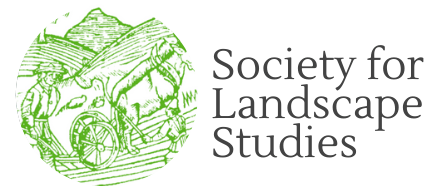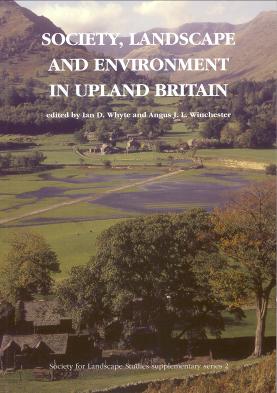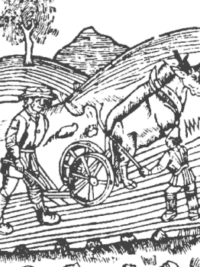Society, Landscape and Environment in Upland Britain
Supplementary Series: 2 (2004)
Edited by Ian D. Whyte and Angus J. L. Winchester
The aim of this book is to chart aspects of the history of human activity in the uplands of Britain during the historic period, in order to help illuminate and understand the face of the uplands of the present day.
CONTENT: 179 pp, 7 tables, 40 illustrations, 12 colour plates, 14 b&w plates
PRICE: £10
Abstracts from this volume
1. Ecological changes on the North York Moors during the last millennium and their impact on the landscape. Margaret Atherden
The chapter examines a range of sources of evidence for ecological change over the last thousand years on this distinctive and well-researched upland area. Particular emphasis is given to the evidence of pollen analysis, the documentary and environmental evidence for climatic change and the evidence of past ecological changes that can be derived from studies of modern vegetation communities.
2. Palaeoecology and political history: evaluating driving forces in historic landscape change in southern Scotland. Richard Tipping
The chapter reviews some of the problems involved in matching the evidence for environmental and landscape change obtained by environmental scientists with the data derived from historical records. To demonstrate how such evidence can be integrated two cases studies are developed from upland areas of southern Scotland: Swindon Hill in the upper part of the Bowmont Water in the northern Cheviot Hills and Dogden Moss in the Lammermuir Hills. Some of the pitfalls of trying to match relatively precise but localised environmental evidence with broader historical trends in order to produce an understanding of landscape change are discussed.
3. Moorland forests of medieval England. Angus J. L. Winchester
From the Cheviot Hills to Dartmoor, large parts of upland England had the status of ‘forest’ or ‘free chase’ during the middle ages. In theory, land protected as hunting reserves for feudal overlords, these areas were nevertheless exploited extensively for livestock production and as a frontier for settlement. In the face of the growth of stock farming in the medieval uplands, the boundaries of forests and chases retreated into the heart of the uplands. By the sixteenth century, many dales in the Pennines and Lake District contained settled hill farming communities and were forests only in name, but vestiges of true forest, retained in demesne by superior lords, remained as tracts of unsettled moorland waste. Despite attempts to enforce traditional forest rules, the numbers of deer dwindled in the face of competition from cattle and sheep.
4. Cornish uplands: medieval, post-medieval and, modern extents. Peter Herring
The changing extent of the Cornish uplands from medieval to recent times is examined together with the processes that reduced and sometimes entirely removed areas of upland in the peninsula. The role of upland areas in the economies of medieval and post-medieval rural communities is considered. A detailed case study of the impact of these changes on Bodmin Moor is provided. Piecemeal enclosure caused increasing disaggregation of formerly coherent and extensive upland areas the perceptions of which steadily faded among local communities.
5. The Commons and the Waste: use and misuse in mid-Wales. R. J. Silvester
The uses of commons within the historic county of Radnorshire are considered from medieval to recent times. Lack of documentation makes it impossible to reconstruct precisely the extent of the commons in medieval times but landscape evidence of medieval farmsteads and larger nucleations helps to establish the limits of settlement at this period. A wider range of historical sources from the sixteenth century provides a clearer picture of the uses of wastes and commons and the pressures on them. The seasonal use of upland pastures and the impact of enclosure are examined and a wide range of uses of the commons in the nineteenth century is considered.
6. The Scottish Highlands before and after the Clearances: an ecological perspective. Robert A. Dodgshon
The ecological basis of traditional Highland farming is examined and the changes brought about by the Highland Clearances considered with particular attention on stocking patterns and grazing levels. Traditional Highland farming was valley-based and oriented towards crop production with only limited use being made of the hill ground. The new systems of commercial sheep farming maximised the use of resources across all sectors of Highland farms, including the high ground. One result of this was pasture degradation with a reduction of heather moorland, and a shift from species-rich to species-poor grassland being commented on by the mid-nineteenth century.
7. Parliamentary enclosure in the uplands. John Chapman
Parliamentary enclosure in the uplands has attracted relatively little research. The distinctive reasons behind enclosure in the uplands are examined, particularly the pressures facing the management of upland commons. The extent of parliamentary enclosure in upland areas of England and Wales is then assessed. The particular problems facing enclosure commissioners in upland areas are discussed and the extent to which enclosure actually led to land improvement.
8. Beyond enclosure: upland common land in England and Wales since 1800. Eleanor A. Straughton
A significant acreage of common land remains in the mountains, moors and fells of England and Wales; landscapes where parliamentary enclosure had incomplete and idiosyncratic effect. Looking beyond enclosure, this chapter asks for greater awareness of upland common land and common agriculture. The chapter argues for close analysis of ‘communal’ grazing customs and institutions existing within a changing cultural and political environment. Further, it is suggested that a global debate on ‘common pool resources’ informs analysis of upland commons and reaffirms their international importance.
9. Fuel economy and the uplands: the effects of peat and turf utilisation on upland landscapes. Ian D. Rotherham, David Egan & Paul A. Ardron
Although the nature of the Norfolk Broads as flooded medieval peat workings has been known for some time less attention has been given to the scale of peat removal for domestic consumption in upland areas and the impact of such removal on upland landscapes and ecology. The scale of upland peat removal is evaluated and its environmental impact discussed, and an assessment made of the effects on upland landscape and ecology.
10. The landscape and environmental impact of mining and quarrying in upland Britain. Ian D. Whyte
Industrial landscapes often survive best in upland areas where they have been less disturbed than in the lowlands. The chapter looks at the landscape evidence for, and environmental impact of, mining and quarrying in upland Britain, focusing on the period from the sixteenth to the early twentieth century. The role of changing technology is considered together with the problems of generating power in remote upland areas and processing metallic ores. The transport problems involved in mining in such difficult environments are then reviewed and a range of environmental impacts caused by mineral and rock extraction are examined.
11. North Snowdonia: an upland landscape under pressure. Mark Brayshay & Andrew Williams
The nature of landscape development in upland areas is discussed and a case made for many areas being affected by relatively brief phases of rapid change punctuating longer-term continuity. This model is discussed in relation to north Snowdonia from medieval to recent times. An area often described as a ‘natural’ landscape is shown to be a highly dynamic one in which the culture, activities and farming methods of the inhabitants have been crucial in fashioning and re-fashioning the appearance of the area.
12. Gendering an upland landscape: masculinity and place identity in the Peak District, 1880s–1920s. Melanie Tebbutt
This chapter argues that landscapes are more than static physical locations; they are also formed in the imagination, mediated by art and literature and informed by popular culture affected by social, cultural and ideological differences. These insights are developed in the context of the landscapes of the Peak District between the 1880s and the 1920s. Emphasis is laid on how certain kinds of masculine values became identified with particular kinds of landscape in this area, especially the Dark Peak and particularly during and following the First World War.
13. A kind of national property? Guy M. Robinson
The chapter reviews the ways in which upland landscapes in Britain have become seen as the embodiment of natural heritage and a focus for both traditional and new forms of recreation, starting with the work of Romantic writers in the early nineteenth century. The origins of concerns over upland landscapes and their conservation are examined and the movement for the establishment of national parks considered, leading to a discussion of modern management issues within upland national parks and Areas of Outstanding Natural Beauty. The need for sensitive management strategies in order to cope with the multiplicity of ideas regarding what functions our upland areas should fulfil is paramount.



